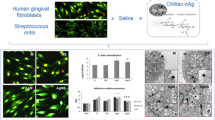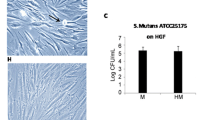Abstract
This study aimed to investigate the effect of saliva on Streptococcus mitis free cells and on S. mitis/human gingival fibroblasts (HGFs) co-culture model, in presence of 2-hydroxyethyl-methacrylate (HEMA). The bacterial aggregation both in the planktonic phase and on HGFs, as well as the apoptotic and necrotic eukaryotic cells amount were analyzed, in presence of saliva and/or HEMA. The aggregation test revealed a significant saliva aggregation effect on S. mitis strains compared to the untreated sample. No significant differences were recorded in the amount of culturable bacteria in all studied conditions; however, from microscopy images, the saliva/HEMA combining effect induced a significant bacterial aggregation and adhesion on HGFs. HEMA treatment decreased viable eukaryotic cell number with a parallel increment of necrotic cells, but when saliva was added to the co-culture, the viable cells percentage increased to a value comparable to the control sample.




Similar content being viewed by others
References
Kolenbrander PE, Palmer RJ Jr, Periasamy S, Jakubovics NS. Oral multispecies biofilm development and the key role of cell–cell distance. Nat Rev Microbiol. 2010;8:471–80.
Dahlén G. Bacterial infections of the oral mucosa. Periodontology (2000). 2009;49:13–38.
Li J, Helmerhorst EJ, Leone CW, Troxler RF, Yaskell T, Haffajee AD, et al. Identification of early microbial colonizers in human dental biofilm. J Appl Microbiol. 2004;97:1311–8.
Avila M, Ojcius DM, Yilmaz O. The oral microbiota: living with a permanent guest. DNA Cell Biol. 2009;28:405–11.
Mager DL, Ximenez-Fyvie LA, Haffajee AD, Socransky SS. Distribution of selected bacterial species on intraoral surfaces. J Clin Periodontol. 2003;30:644–54.
Zähner D, Gandhi AR, Yi H, Stephens DS. Mitis group streptococci express variable pilus islet 2 pili. PLoS One. 2011;6:e25124.
Hohwy J, Reinholdt J, Kilian M. Population dynamics of Streptococcus mitis in its natural habitat. Infect Immun. 2001;69:6055–63.
Mitchell J. Streptococcus mitis: walking the line between commensalism and pathogenesis. Mol Oral Microbiol. 2011;26:89–98.
Papaioannou W, Gizani S, Haffajee AD, Quirynen M, Mamai-Homata E, Papagiannoulis L. The microbiota on different oral surfaces in healthy children. Oral Microbiol Immunol. 2009;24:183–9.
Pearce C, Bowden GH, Evans M, Fitzsimmons SP, Johnson J, Sheridan MJ, et al. Identification of pioneer viridans streptococci in the oral cavity of human neonates. J Med Microbiol. 1995;42:67–72.
Aas JA, Paster BJ, Stokes LN, Olsen I, Dewhirst FE. Defining the normal bacterial flora of the oral cavity. J Clin Microbiol. 2005;43:5721–32.
Husain E, Whitehead S, Castell A, Thomas EE, Speert DP. Viridans streptococci bacteremia in children with malignancy: relevance of species identification and penicillin susceptibility. Pediatr Infect Dis J. 2005;24:563–6.
Ausiello P, Cassese A, Miele C, Beguinot F, Garcia-Godoy F, Di Jeso B, et al. Cytotoxicity of dental resin composites: an in vitro evaluation. J Appl Toxicol. 2013;33:451–7.
Szczepanska J, Poplawski T, Synowiec E, Pawlowska E, Chojnacki CJ, Chojnacki J, et al. 2-Hydroxylethyl methacrylate (HEMA), a tooth restoration component, exerts its genotoxic effects in human gingival fibroblasts trough methacrylic acid, an immediate product of its degradation. Mol Biol Rep. 2012;39:1561–74.
Khalichi P, Cvitkovitch DG, Santerre JP. Effect of composite resin biodegradation products on oral streptococcal growth. Biomaterials. 2004;25:5467–72.
Takahashi Y, Imazato S, Russell RR, Noiri Y, Ebisu S. Influence of resin monomers on growth of oral streptococci. J Dent Res. 2004;83:302–6.
Santos-Daroz CB, Oliveira MT, Góes MF, Nikaido T, Tagami J, Giannini M. Bond strength of a resin cement to dentin using the resin coating technique. Braz Oral Res. 2008;22:198–204.
Garcia FC, Wang L, Pereira LC, de Andrade E, Silva SM, Júnior LM, Carrilho MR. Influences of surface and solvent on retention of HEMA/mixture components after evaporation. J Dent. 2010;38:44–9.
Imazato S, McCabe JF, Tarumi H, Ehara A, Ebisu S. Degree of conversion of composites measured by DTA and FTIR. Dent Mater. 2001;17:178–83.
Cetinguc A, Olmez S, Vural N. HEMA diffusion from dentin bonding agents in young and old primary molars in vitro. Dent Mater. 2007;23:302–27.
Michelsen VB, Kopperud HB, Lygre GB, Björkman L, Jensen E, Kleven IS, Svahn J, Lygre H. Detection and quantification of monomers in unstimulated whole saliva after treatment with resin-based composite fillings in vivo. Eur J Oral Sci. 2012;120:89–95.
D’Ercole S, Di Giulio M, Grande R, Di Campli E, Di Bartolomeo S, Piccolomini R, Cellini L. Effect of 2-hydroxyethyl methacrylate on Streptococcus spp. biofilms. Lett Appl Microbiol. 2011;52:193–200.
Zara S, Di Giulio M, D’Ercole S, Cellini L, Cataldi A. Anti-adhesive and pro-apoptotic effects of 2-hydroxyethyl methacrylate on human gingival fibroblasts co-cultured with Streptococcus mitis strains. Int Endod J. 2011;44:1145–54.
Di Giulio M, D’Ercole S, Zara S, Cataldi A, Cellini L. Streptococcus mitis/human gingival fibroblasts co-culture: the best natural association in answer to the 2-hydroxyethyl methacrylate release. APMIS. 2012;120:139–46.
Humphrey SP, Williamson RT. A review of saliva: normal composition, flow, and function. J Prosthet Dent. 2001;85:162–9.
Hahnel S, Rosentritt M, Handel G, Bürgers R. Surface characterization of dental ceramics and initial streptococcal adhesion in vitro. Dent Mater. 2009;25:969–75.
Falconi M, Teti G, Zago M, Pelotti S, Breschi L, Mazzotti G. Effects of HEMA on type I collagen protein in human gingival fibroblasts. Cell Biol Toxicol. 2007;23:313–22.
Lee SF, Boran TL. Roles of sortase in surface expression of the major protein adhesin P1, saliva-induced aggregation and adherence, and cariogenicity of Streptococcus mutans. Infect Immun. 2003;71:676–81.
Van Landuyt KL, Snauwaert J, De Munck J, Peumans M, Yoshida Y, Poitevin A, et al. Systematic review of the chemical composition of contemporary dental adhesives. Biomaterials. 2007;28:3757–85.
Santerre JP, Shajii L, Leung BW. Relation of dental composite formulations to their degradation and the release of hydrolyzed polymeric-resin-derived products. Crit Rev Oral Biol Med. 2001;12:136–51.
Tamura M, Hirano Y, Hayashi K. The phenomenon of salivary protein adsorption onto Streptococcus mitis ATCC 903 cells. J Oral Sci. 1999;41:169–72.
Okahashi N, Nakata M, Terao Y, Isoda R, Sakurai A, Sumitomo T, et al. Pili of oral Streptococcus sanguinis bind to salivary amylase and promote the biofilm formation. Microb Pathog. 2011;50:148–54.
Cowan MM, van der Mei HC, Rouxhet PG, Busscher HJ. Physico-chemical and structural properties of the surfaces of Peptostreptococcus micros and Streptococcus mitis as compared to those of mutans streptococci, Streptococcus sanguis and Streptococcus salivarius. J Gen Microbiol. 1992;138:2707–14.
Ligtenberg AJ, Walgreen-Weterings E, Veerman EC, de Soet JJ, de Graaff J, Amerongen AV. Influence of saliva on aggregation and adherence of Streptococcus gordonii HG 222. Infect Immun. 1992;60:3878–84.
di Giacomo V, Pacella S, Rapino M, Di Giulio M, Zara S, Pasquantonio G, et al. pPKCα regulates through integrin β 1 human gingival fibroblasts/Streptococcus mitis adhesion in response to HEMA. Int Endod J. 2013. doi: 10.1111/iej.12113
Sliepen I, Van Damme J, Van Essche M, Loozen G, Quirynen M, Teughels W. Microbial interactions influence inflammatory host cell responses. J Dent Res. 2009;88:1026–30.
Acknowledgments
This research was supported by FIRB-Accordi di Programma 2010, ‘Processi degenerativi dei tessuti mineralizzati del cavo orale, impiego di biomateriali e controllo delle interazioni con i microrganismi dell’ambiente’, (RBAP1095CR_001), Prof. A. Cataldi.
Author information
Authors and Affiliations
Corresponding author
Rights and permissions
About this article
Cite this article
Di Giulio, M., di Giacomo, V., Di Campli, E. et al. Saliva improves Streptococcus mitis protective effect on human gingival fibroblasts in presence of 2-hydroxyethyl-methacrylate. J Mater Sci: Mater Med 24, 1977–1983 (2013). https://doi.org/10.1007/s10856-013-4949-7
Received:
Accepted:
Published:
Issue Date:
DOI: https://doi.org/10.1007/s10856-013-4949-7




